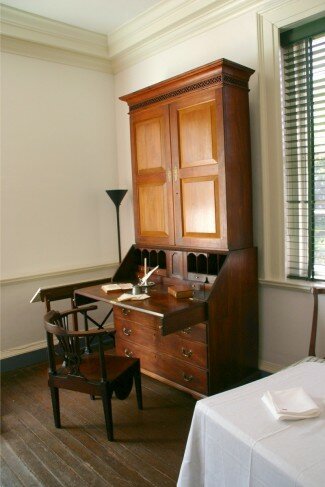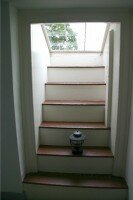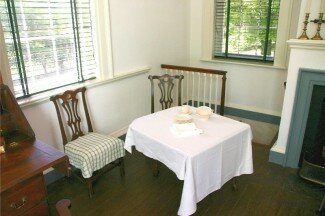Bowman’s unveiling: New Monticello boss opens rarely seen rooms
 Monticello’s chief executive Leslie Greene Bowman stands in the third-floor Dome Room, which will finally be open to the public on June 11.
Monticello’s chief executive Leslie Greene Bowman stands in the third-floor Dome Room, which will finally be open to the public on June 11.PHOTO BY DAVE MCNAIR
Monticello was designed for the pleasure and architectural curiosity of its owner, but as a new tour and exhibit will show, it was also designed for the enslaved workers who moved about the house relatively unseen, serving food, changing linens, and emptying chamber pots.
On Tuesday, May 25, the folks at Monticello gave the press a sneak peek at rooms that have never been opened to the public. It’s all part of a new “behind the scenes” tour that will launch June 11, accompanied by a new exhibit in the cellar level called “Crossroads,” all to shed light on the intersections between Jefferson, his family and guests, and the enslaved workers.
“We’re trying to make Monticello a more lively and entertaining experience,” says Susan Stein, Monticello’s senior curator.
Indeed, during Tuesday’s tour, reporters were led through the cellar complex to the to-be-restored “office,” a sort of staging area where food was carried before being served upstairs in the dining room.
For an additional $15 over the base tour rate of $22, visitors will now be able to climb the very steep and narrow stairway to the third floor— definitely not recommended for the frail, the obese, or those carrying small children. The expanded tour opens the second and third floors, where various guest and family rooms are on display, as well as the restored Dome Room.
On the second floor, Monticello’s manager of special programs, David Ronka, showed visitors the room of one of Jefferson’s granddaughters, Ellen Wayles Randolph Coolidge, which happens to be directly over her grandfather’s office. Ellen, Ronka said, described listening to “Grand-Papa” humming Scottish folk songs below. The room, nearly identical to another semi-octagonal room on the other side of the house, features built-in alcove beds and two floor-level windows that open sideways on pivots. Ronka said the windows were designed that way to give the illusion from the outside that the colossal house has only two stories.
Upstairs, the hallway and rooms that served as bedrooms for Jefferson’s grandchildren during his retirement have skylights with overlapping panes to prevent leaking during heavy rains. Thanks to the skylights— Monticello has 13— the third floor is much brighter than the second.
The hallway skylights include stair treads for access to the roof, and round “cat door” holes in the doors to the rooms, which allowed Jefferson’s felines to freely hunt the rats that tried to inhabit the home’s top floor. And, of course, there’s the beautifully restored Dome Room.
“It was mostly constructed to be seen from the outside,” said Ronka, alluding to the exterior’s most recognizable feature. “But we don’t know what the purpose of the room was.”
Ironically, it is perhaps one of the most beautiful rooms in the house, a Mars yellow Palladio-inspired “temple” with circular windows and an oculus skylight.
For several months after Thomas Jefferson Randolph was married, his grandfather allowed him and his bride to live in the Dome Room, but it appears never to have had a formal function. And at the time of Jefferson’s death, Ronka said, it was relegated to storage space.
At one time, a hidden space at the back of the room, accessed through a tall doorway, was used by his granddaughters as a secret reading and writing placed called the “cuddy” (typically a small cabin on a boat), where they could escape the constant activity within the house.
“I have never told you of the nice little cuddy that has become my haunt, and from which I am now writing. Do you recollect the place over the parlour’s Portico into which the dome room opened? Since the columns to the portico have been completed, Grand-Papa has had the great work bench removed from it, and a floor layed. Corneilia’s ingenuity in conjunction with mine formed steps from the dome into this little closet with a pile of boxes, and having furnished this apartment with a sopha to lounge upon…”— Virginia Jefferson Randolph Trist to Nicholas Philip Trist, 1823
The South Pavilion, which served as living quarters for Jefferson and his wife during the two-year construction phase of the main house, has also been restored. Unfortunately, visitors will be able to view the newlywed Tom and Martha’s quarters only through the glass doors. The two-story space— living quarters above, kitchen below— is only about 15 x 15, but the Jeffersons’ eldest daughter, also named Martha, was born there and must have slept on the recently returned original “co-sleeper” bed.
The Crossroads exhibit will feature life-sized figures of the cast of characters who kept the house running. Other additions include the restoration of Jefferson’s wine cellar— the first cellar dug at the house— as well as a dumbwaiter that inconspicuously transported bottles of wine up to a dining room that has undergone a profound change of its own.
Anyone who has visited the house since 1936 will instantly notice that walls of light blue are now bright yellow, a change made possible by new technologies that helped determine the original color.
 The Jeffersons’ bed in the South Pavilion, along with the original co-sleeper in which first-born daughter Martha slept.
The Jeffersons’ bed in the South Pavilion, along with the original co-sleeper in which first-born daughter Martha slept.PHOTO BY DAVE MCNAIR
 Jefferson’s desk in the South Pavilion, where he presumably planned the construction of the main house.
Jefferson’s desk in the South Pavilion, where he presumably planned the construction of the main house.PHOTO BY DAVE MCNAIR
Download files »
- http://www.monticello.org/press/newsletter/2010/01/NewViewsSmr10.pdf










Great to see Monticello making more of Jefferson accessible through his works, designs and intimate spaces. Other than some candle-lit tours during the holidays, I don’t think the Monticello experience has changed much in decades. Long overdue.
I AGREE ! Change was needed and I will certanly take the time to go see the new tour. July is a good time when the corkscrew vines are blooming .
Dakota